
Nottinghamshire is a ceremonial and non-metropolitan county in the East Midlands, England. A landlocked county, it is bordered by South Yorkshire to the north-west, Lincolnshire to the east, Leicestershire to the south, and Derbyshire to the west. The most-populated settlement is the City of Nottingham, which is administered as a unitary authority area. Nottinghamshire County Council, which administers the rest of the county, is based at West Bridgford in Rushcliffe. In 2017, the population was estimated to be 785,800.

Pleasleylisten (help·info) is a village and civil parish with parts in both Derbyshire and Nottinghamshire. It lies between Chesterfield and Mansfield, 5 miles (8 km) south east of Bolsover, Derbyshire, England and 2.5 miles (4 km) north west of Mansfield, Nottinghamshire. The River Meden, which forms the county boundary in this area, runs through the village.
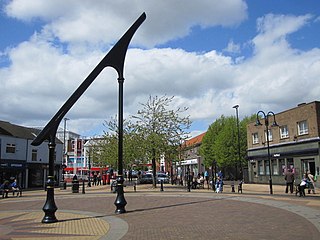
Ashfield is a local government district in Nottinghamshire, England. The population of Ashfield was 127,200 in 2018. The district is mostly urban and forms part of both the Nottingham and Mansfield Urban Areas. There are three towns in the district; Sutton-in-Ashfield, Kirkby-in-Ashfield and Hucknall. The district was formed on 1 April 1974, under the Local Government Act 1972, by the merger of urban districts of Hucknall, Kirkby-in-Ashfield, Sutton-in-Ashfield and parts of Basford Rural District, namely the parishes of Annesley, Felley and Selston.
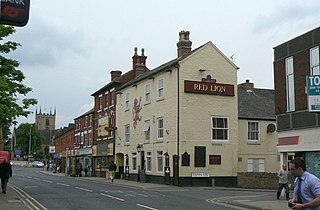
Hucknall, formerly Hucknall Torkard, is a market town in the Ashfield district of Nottinghamshire, England. It lies 7 miles north of Nottingham, 7 miles south-east of Kirkby-in-Ashfield, 9 miles from Mansfield and 10 miles south of Sutton-in-Ashfield. It is the second largest town in the Ashfield district after Sutton-in-Ashfield.

Sutton-in-Ashfield is a market town in Nottinghamshire, England, with a population of 48,527 in 2019. It is the largest town in the district of Ashfield, four miles west of Mansfield, two miles from the Derbyshire border and 12 miles north of Nottingham.
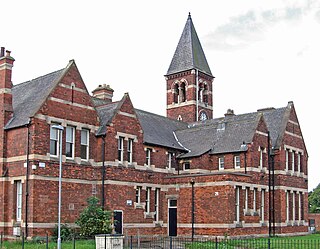
Bestwood Village is an area and civil parish in the Gedling district of Nottinghamshire. Until 1 April 2018 it was part of the civil parish of Bestwood St. Albans. A small part of the village falls within the Ashfield district council area. There have been several new housing estates built recently including the redevelopment of the former Bayles and Whylie factory site which was a former glue mill. It is to the east of Hucknall and north of Bulwell. It is neighboured to the north by the village of Papplewick. It is also close to the Bestwood Park Estate which is in the City of Nottingham.
Smallthorne is an area in the city of Stoke-on-Trent in Staffordshire, England. It is in the north-east of the city, near Burslem. Smallthorne borders Bradeley and Chell in the north, Norton-in-the-Moors in the east, Sneyd Green in the south, and Burslem in the west.

Huthwaite is a village in Nottinghamshire, England, located to the west of Mansfield, close to the Derbyshire boundary. It is in the Huthwaite and Brierley ward of Ashfield District Council. Before 1907 the village was known as Hucknall-under-Huthwaite and also Dirty Hucknall.

Teversal is a small village in the Ashfield district of Nottinghamshire, England, 3 miles (5 km) west of Mansfield, close to Sutton-in-Ashfield and the boundary with Derbyshire. Former names include Tevershalt, Teversholt, Tyversholtee, Teversale, Tevershall and Teversall.

Skegby is a village and former civil parish, now in the unparished area of Sutton in Ashfield, in the Ashfield district of Nottinghamshire, England, located two miles west of Mansfield and one mile north of Sutton-in-Ashfield, close to Stanton Hill lying on the B6014 road. Skegby sits on both sides of a deep valley near the source of the River Meden. The parish covered about 1,433 acres and used to include the then hamlet of Stanton Hill. In 1931 the parish had a population of 6519.

Sutton Colliery was in the village of Stanton Hill, Nottinghamshire, England. It is now a country park.

Silverhill is an artificial hill near Teversal in Nottinghamshire, and is one of the highest points in the county at 204.3 metres (670 ft). Originally it was a mine spoil heap on the site of the former Silverhill colliery which closed in the 1990s. It was subsequently landscaped in 2005 by Nottinghamshire County Council, with tree planting, numerous footpaths, and a viewpoint. It is now known as Silverhill Woods, and is one of a number of recreation sites in the area. These are linked together by multi-user trails, many of which incorporate the track beds of disused railway lines which once served the various local collieries.
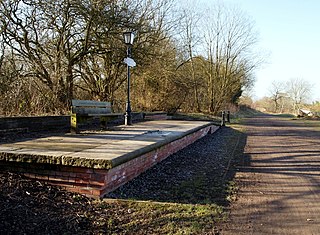
Teversall Manor is a former railway station in Teversal, Nottinghamshire on the Derbyshire border west of Mansfield.
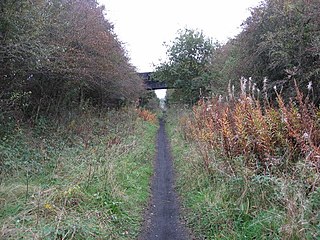
Pleasley East is a former railway station in Pleasley, Derbyshire, England on the Nottinghamshire border near Mansfield.
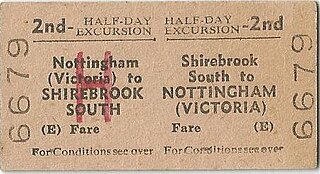
Shirebrook South is a former railway station in Shirebrook, north eastern Derbyshire, England.
Roy Lynk OBE was a leader of the Union of Democratic Mineworkers.
The Leen Valley lines of the Great Northern Railway were railway branch lines built to access the collieries in the Nottinghamshire coalfield in England. The Midland Railway had long been dominant in the area, but there was resentment against its monopolistic policies from coalowners, who encouraged the Great Northern Railway to build a line. The Leen Valley Line was opened in 1881; it ran as far as Annesley colliery. A passenger service was run the following year, and very considerable volumes of coal were hauled.
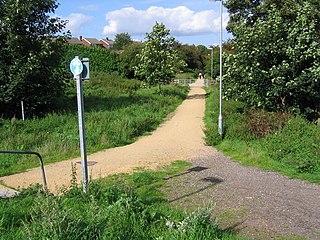
Skeby railway station served the village of Skegby, Nottinghamshire in England.

Sutton-in-Ashfield Town railway station or simply "Sutton Town" railway station served the market town of Sutton-in-Ashfield, Nottinghamshire in England.

Warsop Vale is a small village in the Mansfield district of western Nottinghamshire, England. It is 120 miles (190 km) north west of London, 17+1⁄2 miles (28.2 km) north of the county town and city of Nottingham, and 4+1⁄4 miles (6.8 km) north of the town of Mansfield. It is in the civil parish of Warsop. Warsop Vale's heritage is primarily as a former mining village. It lies in the very picturesque area known as the Dukeries and is easily accessible to Clumber Park, Thoresby Park and hall, Rufford Park and the Earl of Portland estate of Welbeck, together all part of Sherwood Forest.





















